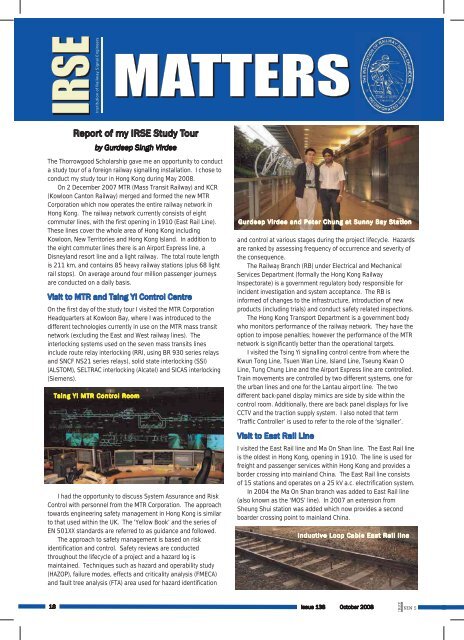IRSE News 138 Oct 08.pdf
IRSE News 138 Oct 08.pdf
IRSE News 138 Oct 08.pdf
You also want an ePaper? Increase the reach of your titles
YUMPU automatically turns print PDFs into web optimized ePapers that Google loves.
Institution of Railway Signal Engineers<br />
Report of my <strong>IRSE</strong> Study Tour<br />
by Gurdeep Singh Virdee<br />
The Thorrowgood Scholarship gave me an opportunity to conduct<br />
a study tour of a foreign railway signalling installation. I chose to<br />
conduct my study tour in Hong Kong during May 2008.<br />
On 2 December 2007 MTR (Mass Transit Railway) and KCR<br />
(Kowloon Canton Railway) merged and formed the new MTR<br />
Corporation which now operates the entire railway network in<br />
Hong Kong. The railway network currently consists of eight<br />
commuter lines, with the first opening in 1910 (East Rail Line).<br />
These lines cover the whole area of Hong Kong including<br />
Kowloon, New Territories and Hong Kong Island. In addition to<br />
the eight commuter lines there is an Airport Express line, a<br />
Disneyland resort line and a light railway. The total route length<br />
is 211 km, and contains 85 heavy railway stations (plus 68 light<br />
rail stops). On average around four million passenger journeys<br />
are conducted on a daily basis.<br />
Visit to MTR and Tsing Yi Control Centre<br />
On the first day of the study tour I visited the MTR Corporation<br />
Headquarters at Kowloon Bay, where I was introduced to the<br />
different technologies currently in use on the MTR mass transit<br />
network (excluding the East and West railway lines). The<br />
interlocking systems used on the seven mass transits lines<br />
include route relay interlocking (RRI, using BR 930 series relays<br />
and SNCF NS21 series relays), solid state interlocking (SSI)<br />
(ALSTOM), SELTRAC interlocking (Alcatel) and SICAS interlocking<br />
(Siemens).<br />
Tsing Yi MTR Control Room<br />
I had the opportunity to discuss System Assurance and Risk<br />
Control with personnel from the MTR Corporation. The approach<br />
towards engineering safety management in Hong Kong is similar<br />
to that used within the UK. The ‘Yellow Book’ and the series of<br />
EN 501XX standards are referred to as guidance and followed.<br />
The approach to safety management is based on risk<br />
identification and control. Safety reviews are conducted<br />
throughout the lifecycle of a project and a hazard log is<br />
maintained. Techniques such as hazard and operability study<br />
(HAZOP), failure modes, effects and criticality analysis (FMECA)<br />
and fault tree analysis (FTA) area used for hazard identification<br />
Gurdeep Virdee and Peter Chung at Sunny Bay Station<br />
and control at various stages during the project lifecycle. Hazards<br />
are ranked by assessing frequency of occurrence and severity of<br />
the consequence.<br />
The Railway Branch (RB) under Electrical and Mechanical<br />
Services Department (formally the Hong Kong Railway<br />
Inspectorate) is a government regulatory body responsible for<br />
incident investigation and system acceptance. The RB is<br />
informed of changes to the infrastructure, introduction of new<br />
products (including trials) and conduct safety related inspections.<br />
The Hong Kong Transport Department is a government body<br />
who monitors performance of the railway network. They have the<br />
option to impose penalties; however the performance of the MTR<br />
network is significantly better than the operational targets.<br />
I visited the Tsing Yi signalling control centre from where the<br />
Kwun Tong Line, Tsuen Wan Line, Island Line, Tseung Kwan O<br />
Line, Tung Chung Line and the Airport Express line are controlled.<br />
Train movements are controlled by two different systems, one for<br />
the urban lines and one for the Lantau airport line. The two<br />
different back-panel display mimics are side by side within the<br />
control room. Additionally, there are back panel displays for live<br />
CCTV and the traction supply system. I also noted that term<br />
‘Traffic Controller’ is used to refer to the role of the ‘signaller’.<br />
Visit to East Rail Line<br />
I visited the East Rail line and Ma On Shan line. The East Rail line<br />
is the oldest in Hong Kong, opening in 1910. The line is used for<br />
freight and passenger services within Hong Kong and provides a<br />
border crossing into mainland China. The East Rail line consists<br />
of 15 stations and operates on a 25 kV a.c. electrification system.<br />
In 2004 the Ma On Shan branch was added to East Rail line<br />
(also known as the ‘MOS’ line). In 2007 an extension from<br />
Sheung Shui station was added which now provides a second<br />
boarder crossing point to mainland China.<br />
Inductive Loop Cable East Rail line<br />
18<br />
Issue <strong>138</strong> <strong>Oct</strong>ober 2008<br />
<strong>IRSE</strong><br />
NEWS

















